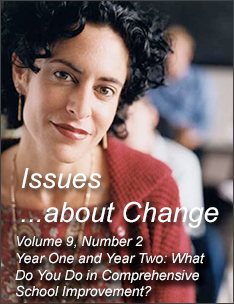Focus of the Improvement Work
Year 1.
In order for partner schools to fully engage in the work of school improvement, the focus of the improvement work that was undertaken was identified and chosen with the full participation of staff at each school. The level and root of difficulty in achieving this objective varied from school to school. For example, Banner High School was reconstituted during the first year of its partnership with SEDL. In its effort to provide students with a sense of community and to encourage personal relationships between students and teachers, this single large high school was divided into four academies. The focus of improvement work quickly became apparent: implementation of the academies concepts and structures.
At San Fernando School, SEDL assisted staff in reviewing achievement data and performing action research. As a result of their learning, staff at San Fernando decided to focus improvement work on student retention of skills, and on curriculum, particularly in mathematics.
The SEDL facilitator at Community High School conducted student focus groups for faculty observation, supported professional development for faculty and administrators, and assisted in the collection and analysis of data from multiple sources in the community and from students. Freshman student success was chosen as the focus of improvement work, and the rest of the first year at Community High was spent identifying leverage points and making plans for implementation in the second year.
At Pelican High School, issues of communication between the central office and the school inserted themselves into efforts to define the focus of improvement work. These issues were worked on as the facilitator introduced the study of student achievement data and its analysis, followed by defining a vision focused on student outcomes. While staff and administrators quickly agreed to focus efforts on improving instructional effectiveness, the consensus broke down when the SEDL facilitator pushed for more specifics. The staff ultimately decided to focus on "planning" as a way of addressing instructional effectiveness.
Student achievement and other forms of data were collected by SEDL staff and utilized to inform staff at Tall Pines Middle School about the academic needs of students and the factors operating within the school that impacted student learning. SEDL facilitated development of a shared vision of exemplary schools through the distribution of research-based studies on successful middle school reform. With this support and guidance, Tall Pines staff identified four areas for improvement: literacy achievement, mathematics achievement; student attendance; and student health, wellness, and safety.
Year 2.
In Year 2, SEDL staff sought to ensure that students remained a visible and vital target of school improvement efforts. At Tall Pines, an administrator from a neighboring school district, trained by staff from SEDL's Program for Teaching and Learning (PITL), developed and delivered professional development for teachers that focused on what students learned - not what teachers taught. As part of their year-long staff development in mathematics instruction, teachers at San Fernando were trained in conducting student interviews, in order to gain insight into the process and success of student learning. To discover and disseminate student priorities and perceptions, SEDL staff conducted student focus groups at San Fernando School, Community High, and Pelican High. At Pelican High School, development of a school improvement plan began as SEDL engaged Pelican staff in a return to the school's mission and vision, and led the staff in reflecting on the skills and attributes of an ideal Pelican High graduate.
These efforts to keep school improvement work focused on students helped to diminish political issues and increase staff enthusiasm and commitment. At Pelican High School, for example, staff who had been adept at blaming external circumstance - district policy, student socio-economic background - for students' lack of success began to see and take responsibility for their impact on students. Staff became both more accountable and more enthusiastic as they planned, implemented, assessed, and revised specific strategies for improved student achievement.
SEDL made available the resources of both its SISS and PITL programs, creating and delivering professional development activities specific to each schools' needs; conducting, analyzing, reporting and guiding revision in response to the assessment of school improvement strategies that were initiated; leading, planning, and attending meetings of school and/or district staff; and providing each school an observer and ally both removed from divisive school issues and fully committed to school improvement and increased student achievement. In addition, SEDL staff brought in outside experts and assisted schools in accessing local resources, and developing relationships between school and district staff, and between the FIRST school and education professionals at neighboring schools and universities.
Reflection.
Lack of access to and understanding of student achievement data played a large role in the difficulties encountered as each partner school sought to define and maintain the focus of their improvement efforts. SEDL spent time at each school gathering existing data, collecting new data, and training school staff in interpreting data and identifying logical, research-tested strategies for school improvement.
In the absence of empirical information about their students' achievement, school staff had developed their own rationale for student achievement and lack of achievement. SEDL staff had to address these "straw men," including: student socioeconomic background; government-mandated programs, standards, and measurements; interpersonal disputes; and other factors outside staff control. SEDL partners pushed school staff to assume responsibility for student learning, and to believe in their ability to positively affect that learning.
Next Page: Organizational Structures

